ARM A53/A57/T760 investigated - Samsung Galaxy Note 4 Exynos Review
by Andrei Frumusanu & Ryan Smith on February 10, 2015 7:30 AM ESTGPU Performance
In the graphics department we're matching up Qualcomm's Adreno 420 versus the Mali T760MP6. The Adreno is running at 600MHz and is able to benefit from almost double the memory bandwidth at 25.6GB/s versus 13.2GB/s due to the Snapdragon's increased 128-bit memory interface. Let's look at how both compare in our overall benchmarks:

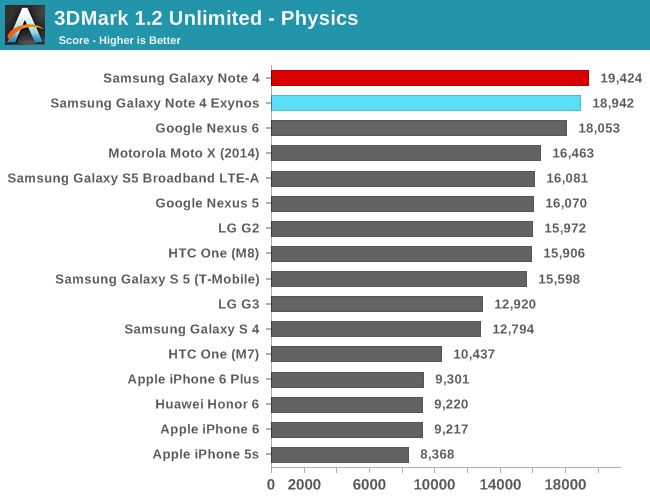
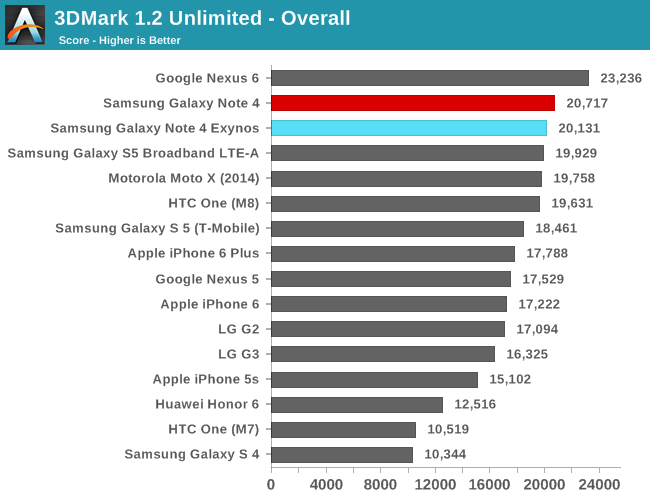
In 3DMark Unlimited the Exynos version comes just short of a few fps behind the Adreno 420. What is also surprising is that the Exynos 5433 performs much better in the physics score than I had anticipated; the same test on Huawei's SoCs limited the thread onto the little cores in the default settings giving mediocre performance results. However, it seems the A53 is performing much better and is able to match Qualcomm's offering now.
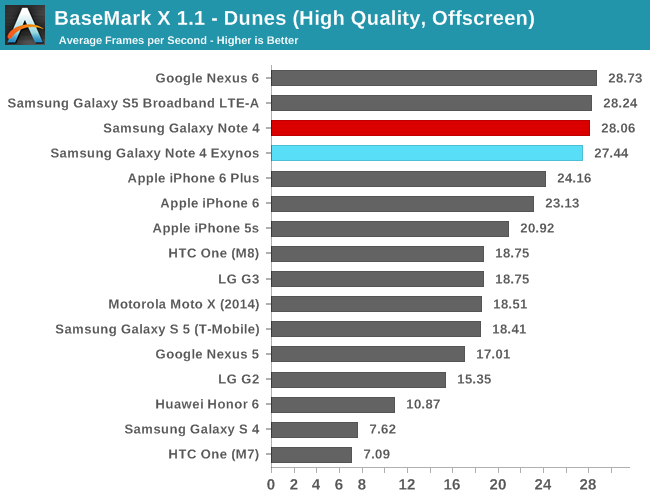
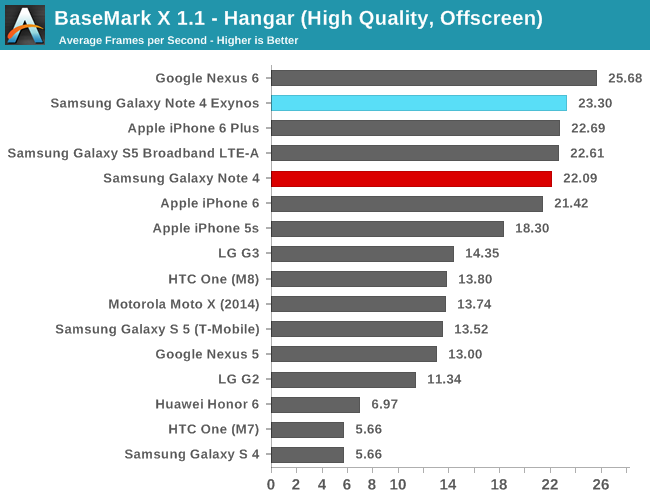
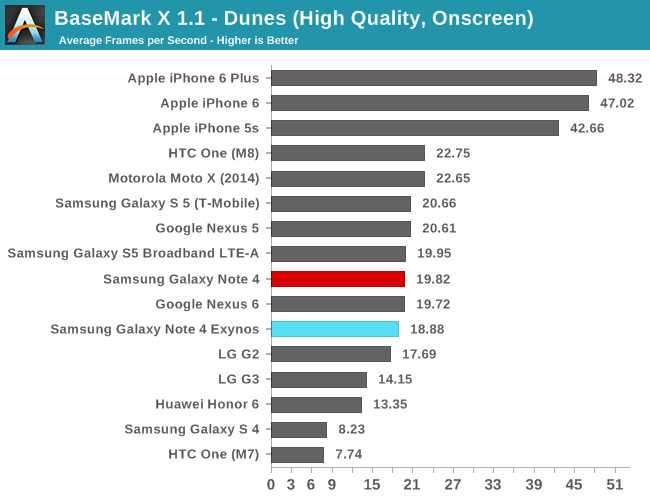

In BaseMark X 1.1, the Exynos is again neck-and-neck with the Snapdragon version. It loses by a slight margin in the Dunes benchmark while winning in the Hangar scenes by a similarly small margin. BaseMark X is again one of the benchmarks that can trigger the 700MHz state of the Mali GPU, offering higher performance at a much higher power draw depending on which scene is currently rendered on both tests.
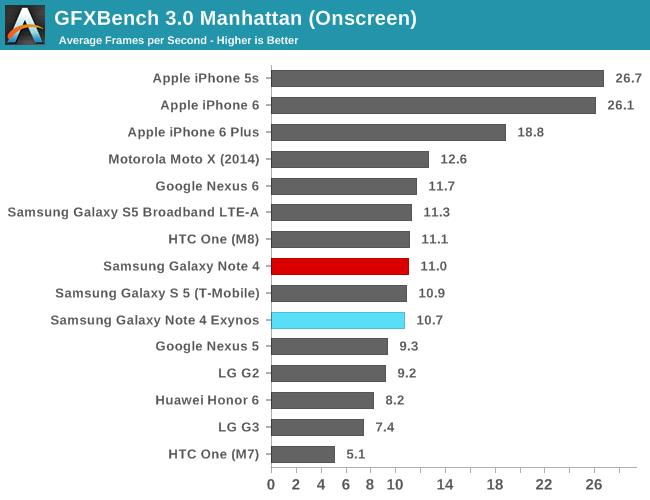
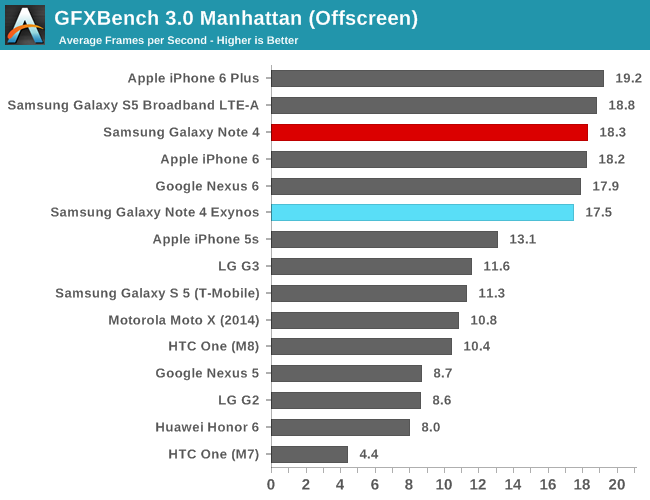
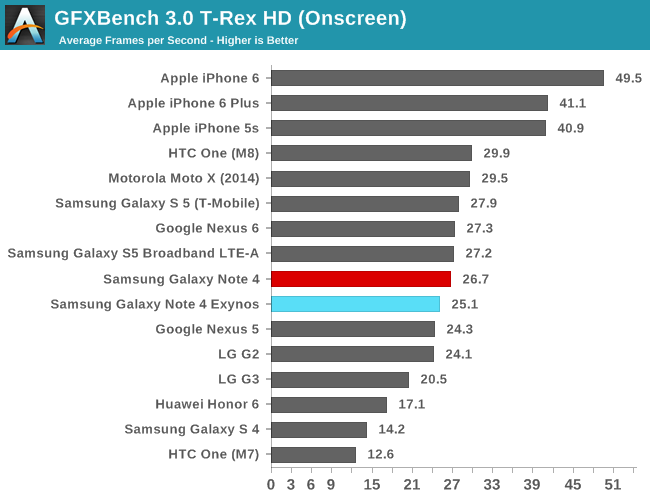
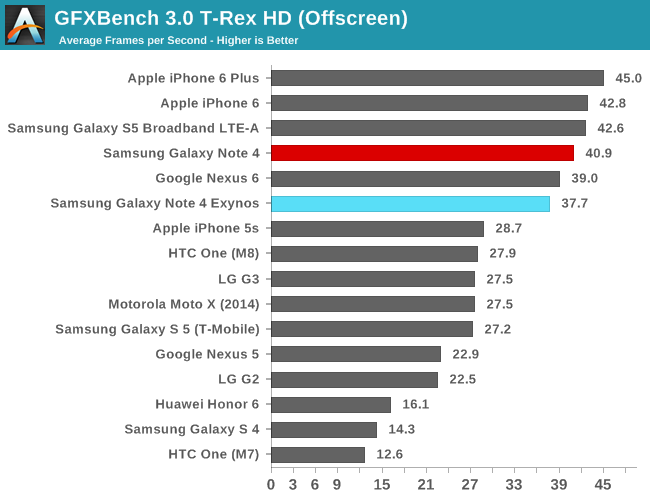
Again we continue to see the same pattern in GFXBench's scenario benchmarks, with the Exynos version lagging a few frames behind the Qualcomm GPU in both Manhattan and T-Rex, in both on-screen and off-screen results.
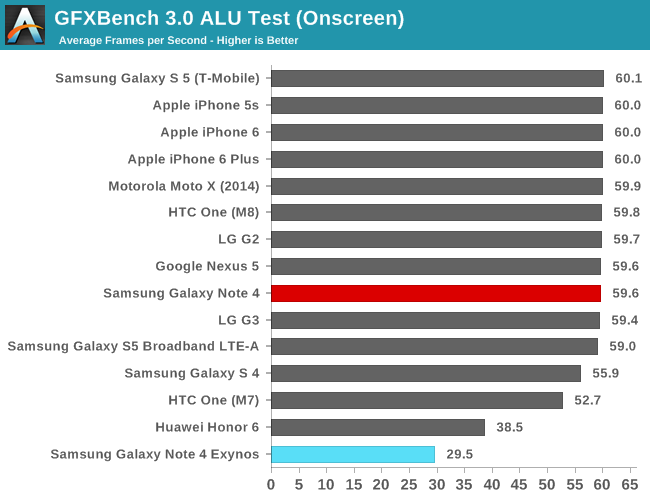

It's on the synthetic tests that we finally see some major deviation between the two architectures. ARM's Mali simply can't seem to keep up with the ALU throughput of Qualcomm's architecture. Both the Adreno 330 and 420 have a clear computational power advantage, exceeding even Imagination's PowerVR GPUs in the iPhones, leaving Mali strictly on the lower end of the performance spectrum.
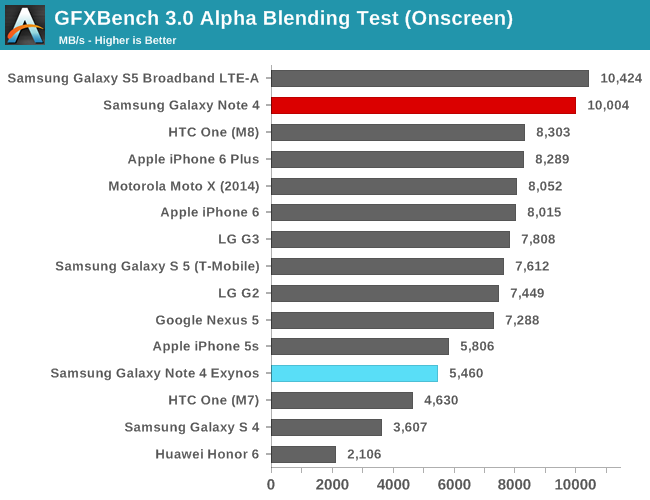
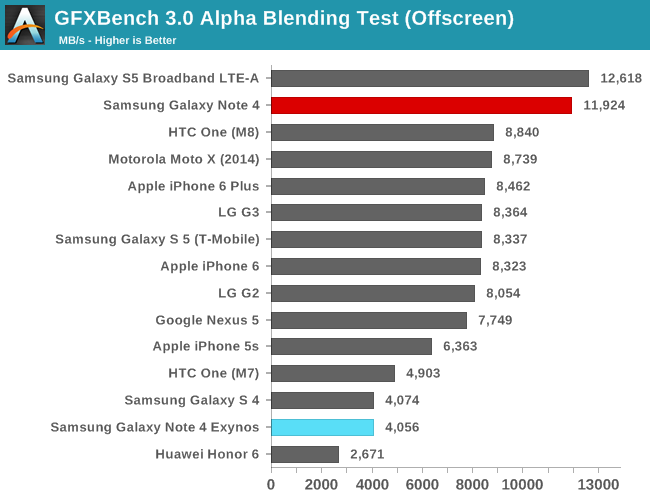
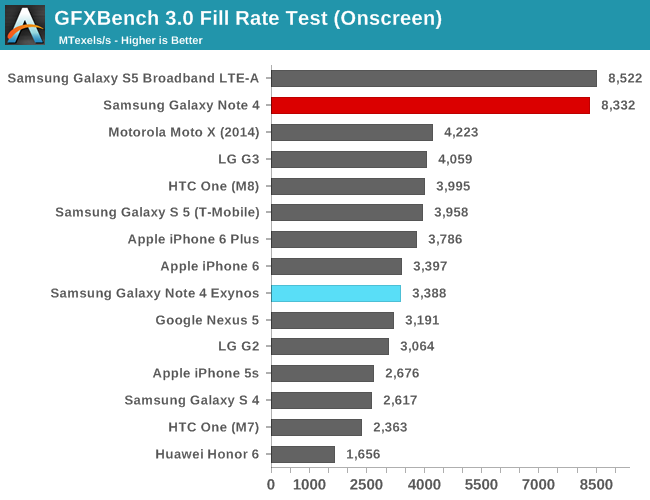
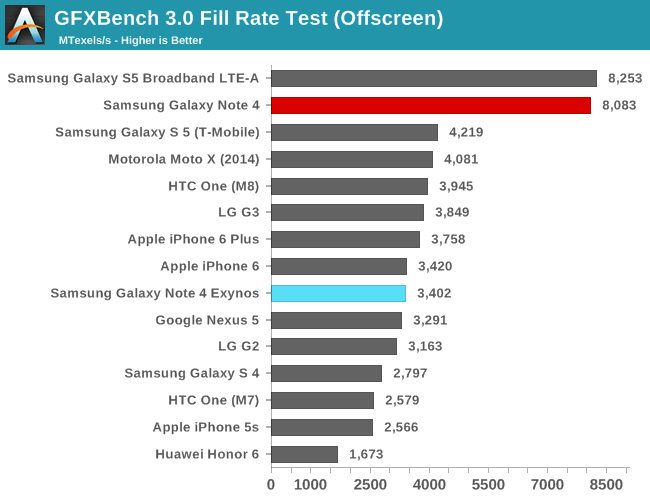
We see a similar situation in the Alpha Blending and Fillrate tests, as the Adreno offers 2-3x the throughput. Utilizing the extra memory bandwidth here seems to be key to the success of the Snapdragon 805's graphics performance.

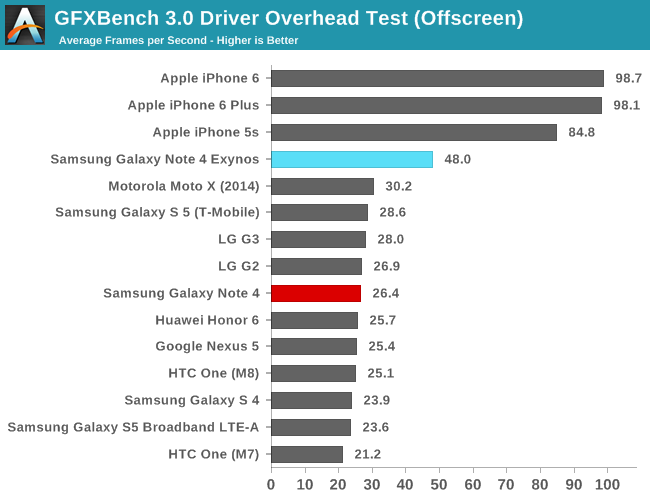
I've already mentioned the Driver Overhead score in the the more in-depth analysis of the T760. It's the first Android device to truly stand out from the rest of the crowd, finally making some progress into trying to catch up with Apple's excellent performance on iOS. Here's hoping more vendors concentrate on improving this metric in future driver updates.
I did some extensive power measurements on the Note 4 Exynos in this review, so naturally we're keen to see how this transforms into our battery benchmarks on the next page.










135 Comments
View All Comments
tipoo - Tuesday, February 10, 2015 - link
I don't know how one can read AT and think this. Read the Nvidia Denver (k1 64) architecture detail. Read the Apple A7 analysis, and by extension that's also the A8. They're not "a57 derivative", they're completely custom.ergo98 - Tuesday, February 10, 2015 - link
Oh save the noise. Both nvidia and Apple are design partners of ARM, and have a long history of deriving from ARM designs. The Apple design (which you seem certain of, despite having zero possible authority to be so) is almost certainly derived from earlier revision A57 designs. Yes, just like Snapdragon they modify and heavily, but a big benefit of being ARM partners is that they don't have to do all of the work themselves.I don't know how you can read Anandtech and not have any rational knowledge of how the semi world works.
Alexvrb - Tuesday, February 10, 2015 - link
They are ISA compatible... but that doesn't mean they're direct derivatives. The custom cores are often quite different in terms of underlying architecture from the reference ARM designs. If it was a simple tweaked ARM design, Qualcomm wouldn't be deploying a reference core in their upcoming flagship - their next-gen custom core isn't ready yet because it takes time.Dmcq - Wednesday, February 11, 2015 - link
If anything the Apple Cyclone looks more like a Dec Alpha EV6/EV7 and the Nvidia Denver is like the Transmeta Crusoe rather than the ARM A15 or A57.tipoo - Wednesday, February 11, 2015 - link
Hide your wrongness in anger, why don't you. They are ISA compatible, nothing more. Apple doesn't even hold an A57 licence, they only licence the ISA now. And Nvidias architecture is very clearly completely different, if you knew what code morphing and VLIW were you would not be arguing this. Save your own noise.tipoo - Wednesday, February 11, 2015 - link
Here, since you can't do your own research. The entire core design is quite different from the relatively narrow A57.http://www.anandtech.com/show/7910/apples-cyclone-...
You could call them "derivative" in that the Core series is derivative of the pentium 3, but still nearly completely different.
doctorpink - Friday, February 13, 2015 - link
Ergo98 : You are so completely lost my friend! LOL Those who replied to you are right.jameskatt - Tuesday, February 10, 2015 - link
Note that the A9 will soon be coming out this year. This means Apple will be 2 generations ahead of the pack when it comes to 64-bit processors. And unlike the Tegra, it is also going into the iPhone, not just a tablet.theduckofdeath - Sunday, February 15, 2015 - link
And the Tegra T2 won't be announced this year? Or the 14nm Exynos processors (You know, the ONLY 14nm mobile processors in the world)DarkLeviathan - Saturday, December 19, 2015 - link
I'm very sure that the Exynos is not the only 14nm processors in the world. And you know that making it a smaller process doesn't make it better right? Just take a look at Chip-gate on the new iPhones. TSMC's 16nm is better than Samsung's 14nm. And apply to their own Exynos processors. Maybe they would do better if they were 16nm too huh?